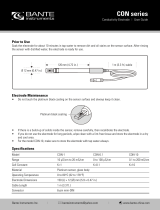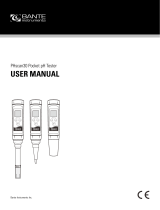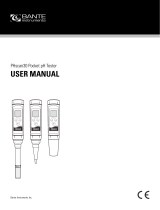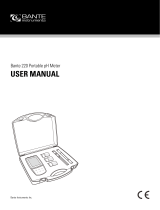Page is loading ...

S series Bluetooth pH/ORP/Ion/Conductivity/DO Testers
USER MANUAL
Bante Instruments Inc.

01 I Contents
Table of Contents
Tester Overview
Environmental conditions ...………………….………………. 03
Packing list ………………………………………………… 03
Installing the batteries ……………………………………… 03
Switching the tester on and off ……………………………… 03
BanteLab App
Download the software ……………………………………… 04
Connecting the tester ………………………………………. 04
Connecting multiple testers ………………………………… 05
Switching the measurement screen…………………………… 05
Function keys ……………………………...………………… 06
General settings …………………………………………… 06
Setting the default option ………………………………….… 07
Setting the sample ID .……………………………………… 07
Storing the measurement data ……………………………… 08
Viewing the data log ………………………………………… 08
Deleting the data log ……………………………….……… 08
Connecting the printer ……………………………………… 09
Printing the measurement data ……………………………… 09
Temperature Calibration …………..………………… 10
S10 pH Tester
Prior to use ………………..………………………………… 12
pH settings ………………………………………………… 12
pH calibration ………………………………………………. 12
• Single point calibration ………………………………… 13
• Multipoint calibration ………………………………… 13
• pH calibration with custom buffers ……………………… 14
Measurements………………………………………………. 14
• pH ……………………….……………………………. 14
• mV ……………………….……………………………. 14
Electrode maintenance ………………………………………. 15
Preparation of pH buffer solutions ……………………………. 15
Preparation of electrode storage solution …………..…………. 15
S20 ORP Tester
Prior to use ………………..………………………………… 18
ORP settings ……………………………………………….. 18
Measurements………………………………………………. 18
ORP calibration ……………………………………………… 19
Electrode maintenance ………………………………………. 19
Preparation of ORP standard solutions………………………… 20
Preparation of electrode storage solution …………..…………. 20
S30 Ion Tester
Prior to use ………………..………………………………… 22
Ion settings …………………………………………………. 22
Temperature compensation ………..………………………… 22
Ion calibration ………………………………………………. 23
Measurements………………………………………………. 25
• Direct reading ….………………………………………. 25
• Known addition ………………………………………… 26
• Known subtraction ……………………………………… 26
• Sample addition………………………………………… 26
• Sample subtraction …………………………………… 26
• mV ……………………………..……………………… 26
Electrode maintenance………………………………………. 27
Preparation of ion standard solution ………..………………… 27
S40 Water Hardness Tester
Prior to use ………………..………………………………… 30
Water hardness settings ……………………………………. 30
Temperature compensation .………..………………………… 30
Water hardness calibration ………………………………….. 31
Measurements………………………………………………. 32
• Water hardness ………………………………………… 32
• mV ……………………….……………………………. 32
Electrode maintenance ………………………………………. 32
Preparation of ion standard solution ………..………………… 32
S50 Conductivity Tester
Prior to use ………………..………………………………… 34
Conductivity/TDS/salinity settings …………………………… 34
Conductivity calibration ……………………………………… 35
• Single point calibration …………………………….…… 35
• Multipoint calibration …………………..………….…… 36
Measurements ……………………………………………. 36
• Conductivity/TDS/salinity/resistivity ……………………. 36
• Conductivity ash ………………………….……………. 36
Electrode maintenance ………………………………………. 37
Preparation of conductivity standard solutions …………...……. 37
Calculating the temperature coefficient ………………….…… 37
Calculating the TDS conversion factor ………………………… 38
S60 Dissolved Oxygen Tester
Prior to use ………………..………………………………… 40
• Filling the electrolyte solution …………………………… 40
• Polarizing the electrode ………………………………… 40
Dissolved oxygen settings …………………………………… 40
Dissolved oxygen calibration ………………………………… 41
Measurements ……………………………………………. 43
• Dissolved oxygen …………………….………………… 43
• BOD…………………………………………………… 43
• OUR/SOUR measurement …………………………….… 45
Electrode maintenance ……………………………………… 46
Preparation of air-saturated water …………………………… 46
Preparation of zero oxygen solution ………………………….. 46

Overview
This section is applicable to all models of the S series testers

03 I Overview
Tester Overview
Thank you for selecting the S series bluetooth water quality tester, this product series includes 6 models.
Model
Measurement Parameters
Sensor ID
S10
pH
PH *********
S20
ORP (mV, relative mV)
POI *********
S30
Ion concentration
ION *********
S40
Water hardness
ION *********
S50
Conductivity, TDS, salinity, resistivity, conductivity ash
EC *********
S60
Dissolved oxygen, BOD, oxygen uptake rate (OUR), specific oxygen uptake rate (SOUR)
DO *********
This user manual provides a step-by-step guide to help you operate the testers and app, please carefully read the following instruction according
to the model you have purchased.
Environmental Conditions
Before unpacking, ensure that current environmental conditions meet the following requirements.
• Relative humidity is less than 80%
• Ambient temperature between 0° C (32° F) and 50° C (122° F)
• No potential electromagnetic interference
Packing List
The following list describes all components of the tester. If any items are missing or damaged, contact the supplier immediately.
Model
Components
S10
Tester, pH buffer solutions 4.01, 7.00, 10.01
S20
Tester, solution storage bottles
S30
Tester, ion selective electrode, standard solutions 100, 1000 ppm, ionic strength adjuster
S40
Tester, water hardness electrode, standard solutions 10, 100 mmol/L, ionic strength adjuster
S50-M
Tester, conductivity standard solutions 84 μS/cm, 1413 μS/cm, 12.88 mS/cm
S50-H
Tester, conductivity standard solutions 1413 μS/cm, 12.88 mS/cm, 111.8 mS/cm
S60
Tester, dissolved oxygen electrode, electrolyte solution, membrane cap
S30-Cn and S30-S ion testers do not provide above solutions.
Installing the Batteries
1. Take out the tester from carrying case. Twist the electrode collar counter clockwise, pull the electrode (or connector) away from the tester.
2. Insert the two AAA alkaline batteries into the battery compartment, note polarity.
3. Push the electrode (or connector) into the tester and twist the electrode collar clockwise until tight.
Switching the Tester On and Off
Press the key to switch on the tester, press the key again to switch off the tester.

Overview I 04
BanteLab App
Download the Software
Bante Instruments provides a powerful app that is used for receiving the data form S series testers. You are able to download this software from
our official website at www.bante-china.com or scan the QR code below. Before installation, make sure that you have Android smartphone or tablet
and this device with Bluetooth 4.0 or newer.
Connecting the Tester
1. Tap the BanteLab icon, the application starts.
2. If you want to print the data with an operator ID, tap and enter the username in the text field .
3. Tap the Enter, the app begins searching for connectable testers, the screen shows a sensor list.
4. Tap the ID and wait until the connection icon appears.
5. Tap the Done to enter the measurement screen.
• The BanteLab app is capable of connecting up to 3 testers for multiparameter measurement. If the icon does not appear during the
connection, please do not tap the ID again.
• If the screen shows "
The sensor has been connected
", but the icon does not appear for a long time. Please switch off the tester and
wait for 10 seconds, then switch on the tester again. If necessary, restart the app.
• If the tester has switched off, but the ID still shows on the screen. Restart the app, the screen will refresh the sensor list.

05 I Overview
Connecting Multiple Testers
During the measurement, if you want to connect multiple testers to app, please follow the steps below.
1. Tap the .
2. Tap the Discover Sensor.
3. Tap the ID and wait until the icon appears.
4. Tap the Done to return to the measurement screen.
Note, the pH, ORP, ion and water hardness testers can not connect to app simultaneously.
Switching the Measurement Screen
The BanteLab app contains two measurement screens in the single parameter measurement mode. The default is graph. Swipe the graphics area,
the data table will show on the screen. If 2 or 3 testers have connected to app, the screen will automatically switch to the multiparameter
measurement mode.

Overview I 06
Function Keys
Icon
Function
Save current reading to memory or send the data to printer (depending on the Data Transfer setting in setup menu)
Lock or unlock the measurement
Select the measurement mode
Return to the single parameter measurement mode
Switch the measurement parameter
Return to the previous screen
General Settings
The BanteLab app contains an integrated setup menu that is used to customize the tester parameters. In the different modes, the screen will show
the corresponding menu items. For the general settings, the option will be applied to all testers once setting is changed.
Menu Item
Option
Description
Default
Temperature Unit
°C
Set the default temperature unit.
°C
°F
Stability Criteria
Fast
Set when a measurement is recognized as stable.
• When the Fast option is selected, the screen will show Stable icon,
quickly, but the repeatability is not good.
• When the Slow option is selected, the icon will take longer to appear,
but guarantees high accuracy of the measurement.
• When the Standard option is selected, the app will balance the
response speed and accuracy.
Standard
Standard
Slow
Measurement Mode
Auto-Read
Set the measurement read type.
• When the Auto-Read is selected, the app will automatically sense a,
stable reading and lock the measurement, the HOLD icon appears on,
the screen.
• When the Continuous read is selected, the reading will continuously,
update.
Continuous
Continuous
Timed Interval Readings
10/30/60/300 seconds
Set the time interval for sending reading to memory or printer.
Off
Off
Calibration Due
1 to 99 days
Set the calibration interval to activate alarm. If the tester is not calibrated,
within a specified time period, the screen will show a reminder.
Off
Off
Data Transfer
Save to memory
Set the data transfer type.
Memory
Send to printer
Password Protect
Enable
Set the password protection for preventing the unauthorized calibration.
and settings. If enabled, the user must enter a 6-digit password to access.
above modes.
Disable
Disable
Multiparameter Display
Enable
If the multiple testers have connected to app, tap this option to return to,
the multiparameter measurement screen.
---
Factory Reset
Enable
Reset the tester to factory default settings. Note that the tester must be,
recalibrated.
Disable
Disable

07 I Overview
Setting the Default Option
1. Tap the Settings and select an option.
2. Tap the Measure to return to the measurement screen.
• If the app is in the multiparameter measurement screen, tap the to enter the single parameter measurement screen.
• Tap the Settings and select an option.
• Tap the Multiparameter Display to return to the measurements.
Setting the Sample ID
1. Tap the Sample ID on the measurement screen.
2. Tap the numeric keypad to enter the 4-digit number.
3. Tap the Done to return to the measurement screen.

Overview I 08
Storing the Measurement Data
1. Ensure that the Data Transfer option in setup menu is switched to Save to memory.
2. Tap the , the screen shows "
Measured value has stored into memory
".
Viewing the Data Log
1. Tap the .
2. Tap the Data Log.
3. Tap the to return to the measurement screen.
Deleting the Data Log
• Delete single data: Tap and hold the data bar, the screen shows "
This log will be deleted
". Tap the Yes to confirm.
• Delete all data: Tap the , the screen shows "
Are you sure you want to delete all logs?
" Tap the Yes to confirm.
Note, deleted data can not be restored.

09 I Overview
Connecting the Printer
Bante Instruments provides a ZJ5890C bluetooth printer for printing the measurement data (sold separately).
1. Switch on the printer.
2. Tap the .
3. Tap the Discover Sensor.
4. Tap the ID: PT ********* and wait until the icon appears.
5. Tap the Done, the screen shows "
Bluetooth pairing request
" and waits for entering the PIN code.
6. Enter the 0000 and confirm, the printer will automatically print the "
Printer is ready
".
Printing the Measurement Data
1. Ensure that the Data Transfer option in setup menu is switched to Send to printer.
2. Tap the to print the displayed reading.
If you need to print the all of stored readings, tap the , tap the Data Log, tap the .

Overview I 10
Temperature Calibration
The S10 and S50 testers are installed with a built-in temperature sensor. During the measurement, if the measured temperature reading differs
from that of an accurate thermometer, the tester should be calibrated.
1. Place the tester into the solution with a known accurate temperature, wait until the measurement is stable.
2. Tap the temperature reading on the measurement screen.
3. Tap the numeric keypad to modify the temperature.
4. Tap the Done to return to the measurement screen.
If the input value exceeds the allowable range, the app will automatically correct the temperature to 0°C or 105° C.

S10
pH Calibration and Measurement
This section is applicable to model S10 tester

S10 I 12
Prior to Use
1. Remove the protective cap and translucent cover from the bottom of the tester. If some salt crystals deposited on the electrode, rinse with
tap water to clean these deposits. If tiny air bubbles are present inside the pH-sensitive glass membrane, gently shake the tester downward
to remove air bubbles. If the glass membrane has dried out, soak the electrode in 3M KCl or pH 4.01 buffer solution for about 30 minutes.
2. Tap the , tap the pH to enter the measurement screen.
pH Settings
The BanteLab app contains 5 pH settings and 9 general settings in the setup menu.
Menu Item
Option
Description
Default
pH Buffer Group
USA
Set the pH buffer group for calibration and auto-
recognition.
USA
NIST
DIN
Custom (any 2 to 5 values >1 pH apart)
Calibration Points
1 to 5 points
Set the number of calibration points.
3 points
Resolution
0.001
Set the resolution of the pH measurement.
0.001
0.01
0.1
Solution Temperature
Coefficient
High purity water
Solution temperature coefficient is used to correct
the pure water sample with a conductivity of less
than 30 µ S/cm. If enabled, the readings will
automatically reference to 25° C (77° F).
Off
Sample contained the ammonia or phosphate
Off
Alarm Limits
Enable
Set the high and low limit values to activate alarm.
Disable
Disable
To change the current settings, refer to the Setting the Default Option section on page 7.
pH Calibration
The S10 tester allows 1 to 5 points calibration in the pH mode. We recommend that you perform at least 2 points calibration for high accuracy
measurement. The tester will automatically recognize and calibrate to following standard buffer values.
USA standard buffers
pH 1.68, 4.01, 7.00, 10.01, 12.45
NIST standard buffers
pH 1.68, 4.01, 6.86, 9.18, 12.45
DIN standard buffers
pH 1.09, 4.65, 6.79, 9.23, 12.75
If the Custom option is selected, the tester will only allow 2 to 5 points calibration. Single point calibration should only be carried out with pH
7.00, 6.86 or 6.79, otherwise calibration will not be accepted.
For better accuracy, we recommend calibrating the tester regularly. DO NOT reuse the buffer solutions after calibration, contaminants in solution
will affect the calibration and eventually the accuracy of the measurement.
3M KCl solution
pH-sensitive glass membrane

13 I S10
Single Point Calibration
Ensure that you have selected 1 point calibration in the setup menu.
1.1 Tap the Calibrate, the screen shows "
Calibration Point 1, 7.00 pH
" (or 6.86, or 6.79 pH, depending on the selected pH buffer group).
1.2 Rinse the electrode with distilled water and place into the pH 7.00 buffer solution, stir the tester gently to create a homogeneous solution.
1.3 Wait for 5 seconds, tap the Confirm to begin the calibration. When the reading has stabilized, the screen will automatically show
"
Calibration is completed
".
Multipoint Calibration
Ensure that you have selected 2 to 5 points calibration in the setup menu.
2.1 Repeat steps 1.1 through 1.3 above. When the first calibration point is completed, the screen will show "
Calibration Point 2
", the app prompts
you to continue with second point calibration.
2.2 Rinse the electrode with distilled water and place into the next buffer solution (e.g., pH 4.01), stir the tester gently.
2.3 Wait for 5 seconds, tap the Confirm, the tester automatically recognizes the buffer solution and begins the calibration.
2.4 When the reading has stabilized, the screen will show "
Calibration Point 3
", the app prompts you to continue with third point calibration.
2.5 Repeat steps 2.2 and 2.3 above until the screen shows "
Calibration is completed
".

S10 I 14
pH Calibration with Custom Buffers
Ensure that you have select the Custom option in the setup menu, the calibration solutions should be at least 1 pH unit apart from each other.
3.1 Rinse the electrode with distilled water and place into the buffer solution, stir the tester gently and wait until the measurement is stable.
3.2 Tap the Calibrate.
3.3 Tap the < or > to set the calibration value.
3.4 Wait for 5 seconds, tap the Confirm to begin the calibration.
3.5 When the reading has stabilized, the screen will show "
Calibration Point 2
", the app prompts you to continue with second point calibration.
3.6 Repeat steps 3.1, 3.3 and 3.4 above until the screen shows "
Calibration is completed
".
To exit the calibration without saving changes, tap the Measure.
Viewing the Calibration Log
4.1 Tap the .
4.2 Tap the Calibration Report.
4.3 Tap the to return to the measurement screen.
• If the tester is not calibrated or custom buffers are used, the calibration report will show ---- only.
• If the calculated electrode slope is not between 70% and 110%, please check the electrode and make sure that the buffer solutions are
fresh and uncontaminated. If the pH buffers are in the good condition, please replace the electrode.
Measurements
pH
Rinse the electrode with distilled water, place the electrode into the sample solution and stir gently. Note, DO NOT completely immerse the tester
in water. Wait for the measurement to stabilize and record the reading.
If the tester installed a spear tip electrode or flat surface electrode (refer to the Optional Accessories > pH Electrodes section on page 16)
and the samples are soft solid or semi-solid, wet the sample with clean water, then slight pressure the electrode to take measure. Note that the
pH-sensitive membrane must be fully touched with sample surface.
• During the measurement, never wipe the pH-sensitive membrane as this will cause static interference, blot dry with a lint-free tissue to
remove waterdrops on electrode.
• If the Auto-Read option is enabled in the setup menu, the app will automatically lock a measurement endpoint and show HOLD icon. Tap the
to resume measuring.
mV
Tap the , tap the mV, the screen shows millivolt readings.

15 I S10
Electrode Maintenance and Replacement
Cleaning the pH Electrode
• Since the pH-sensitive membrane is susceptible to contamination, make sure that rinse the electrode thoroughly with distilled water after use.
• If your sample contains the oil or grease, soak the electrode in mild detergent or electrode cleaning solution for at least 15 minutes, then
rinse with distilled water.
• If you do not use the tester for a period longer than 1 month, store the electrode in 3M KCl solution or electrode storage solution.
DO NOT store the electrode in distilled or deionized water, which will deplete the hydration layer of the pH-sensitive membrane and render
the electrode useless.
Replacing the pH Electrode
If the tester fails to calibrate or gives fluctuating readings, you should consider replacing the electrode.
1. Twist the electrode collar counter clockwise, pull the electrode away from the tester.
2. Align the slot on the new electrode, gently push the electrode into the tester.
3. Twist the electrode collar clockwise until tight.
Appendix
Preparation of pH Buffer Solutions
The S10 tester is packaged with the pH 4.01, 7.00, 10.01 buffer sachets required for calibration.
1. Half fill a 250 ml volumetric flask with distilled water and add the pH 7.00 buffer reagent.
2. Swirl the volumetric flask gently to dissolve the reagent and fill to the mark with distilled water.
3. Cap and upend the volumetric flask several times to mix solution.
• Preparation of pH 4.01 and 10.01 buffer solutions are the same as above.
• Prepared buffer solution should be stored in hermetically sealed glass container and avoid direct sunlight.
Preparation of Electrode Storage Solution
1. Dissolve 24.6 grams of analytical grade KCl reagent in 100 ml distilled water.
2. Add pH 4.01 standard buffer and adjust solution to pH 4.
250 ml

S10 I 16
Optional Accessories
pH Electrodes
Order Code
Description
E-PHscan-ST-10K
• Circular pH-sensitive membrane
• For measuring the general water samples (non-viscous, non-corrosive liquids)
E-PHscan-FT-10K
• Flat surface pH-sensitive membrane
• For measuring the surfaces of semi-solid or gel samples, such as cream, doughs,
paper, textiles, paints, coatings, printing inks, etc.
E-PHscan-LT-10K
• Circular pH-sensitive membrane
• Electrode dimensions: 75 × 12.5 (Ø ) mm
• For measuring the samples in small containers, such as test tube
E-PHscan-PT-10K
• Spear tip pH-sensitive membrane.
• For penetrating and measuring the semi-solid samples, such as soil, vegetables,
fruits, meats, cheeses, etc.
Solutions
Order Code
Description
PHCS-USA
pH 4.01, 7.00, 10.01 buffer solutions, 480 ml
PHCS-NIST
pH 4.01, 6.86, 9.18 buffer solutions, 480 ml
PHCS-ES
Electrode storage solution, 480 ml
PHCS-GC
Electrode cleaning solution, removes inorganic residues, 480 ml
PHCS-PR
Electrode cleaning solution, removes protein contamination, 480 ml

S20
ORP Calibration and mV Measurement
This section is applicable to model S20 tester

S20 I 18
Prior to Use
1. Remove the protective cap and translucent cover from the bottom of the tester. If some salt crystals deposited on the electrode, rinse with
tap water to clean these deposits. If the platinum sensor has dried out, soak the electrode in 4M KCl solution or tap water for about 30 minutes.
2. Tap the , tap the ORP to enter the measurement screen.
ORP Settings
The BanteLab app contains 2 ORP settings and 9 general settings in the setup menu.
Menu Item
Option
Description
Default
Resolution
0.1
Set the resolution of mV measurement.
0.1
1
Alarm Limits
Enable
Set the high and low limit values to activate alarm.
Disable
Disable
To change the current settings, refer to the Setting the Default Option section on page 7.
Measurement
The S20 tester contains two millivolt measurement modes.
• Raw millivolt (mV): Tap the and tap the mV to enter the absolute millivolt measurement mode.
• Relative millivolt (R.mV): Tap the and tap the ORP to enter the relative millivolt measurement mode.
Select one of the above modes. Rinse the electrode with distilled water. Place the electrode into the sample solution and stir gently. Note,
DO NOT completely immerse the tester in water. Wait for the measurement to stabilize and record the reading.
• The platinum sensor may give unstable readings in solutions that contain chromous, vanadous and titanous ions or other ions that are stronger
reducing agents than hydrogen or platinum.
• If the Auto-Read option is enabled in the setup menu, the app will automatically lock a measurement endpoint and show HOLD icon. Tap the
to resume measuring.
4M KCl solution
Platinum sensor

19 I S20
ORP Calibration
The S20 tester allows 1 point calibration in the ORP mode, but calibration is not necessary unless exact readout agreement with a work standard
and at a specific ORP value is needed.
1.1 Rinse the electrode with distilled water and place into the standard solution, stir tester gently and wait until the measurement is stable.
1.2 Tap the Calibrate and tap the < or > to set the calibration value.
1.3 Tap the Confirm to begin the calibration. When the reading has stabilized, the screen will show "
Calibration is completed
".
Viewing the Calibration Log
2.1 Tap the .
2.2 Tap the Calibration Report.
2.3 Tap the to return to the measurement screen.
If the tester is not calibrated, the calibration report will show ---- only.
Electrode Maintenance and Replacement
• Rinse the platinum electrode thoroughly with distilled water after use.
• In the corrosive chemicals, viscous solutions and solutions with heavy metals or proteins, take readings quickly and rinse electrode
immediately.
• If you do not use the tester for a period longer than 1 month, store the electrode in 4M KCl solution or electrode storage solution.
Replacing the ORP Electrode
If the tester fails to calibrate or gives fluctuating readings, you should consider replacing the electrode.
1. Twist the electrode collar counter clockwise, pull the electrode away from the tester.
2. Align the slot on the new electrode, gently push the electrode into the tester.
3. Twist the electrode collar clockwise until tight.
/













